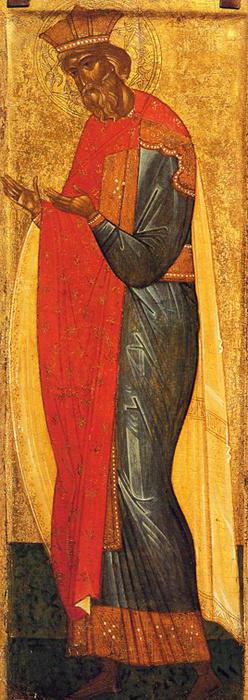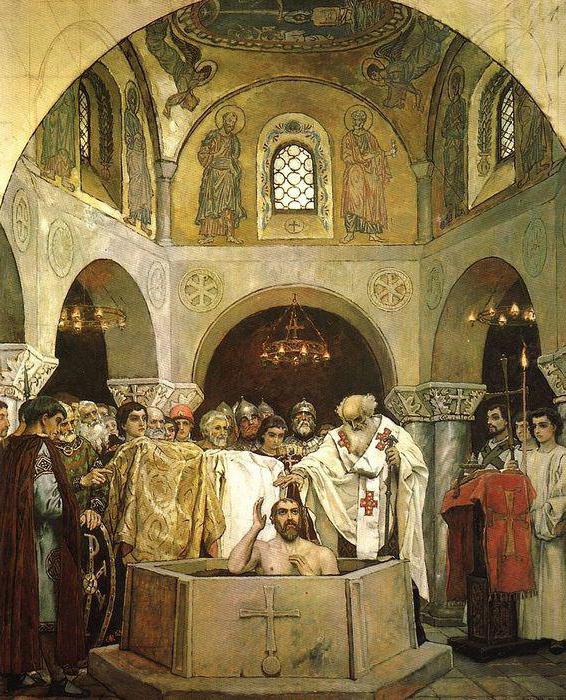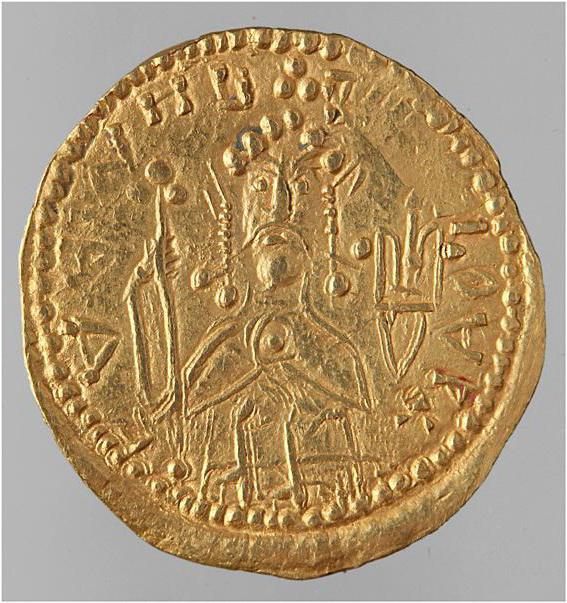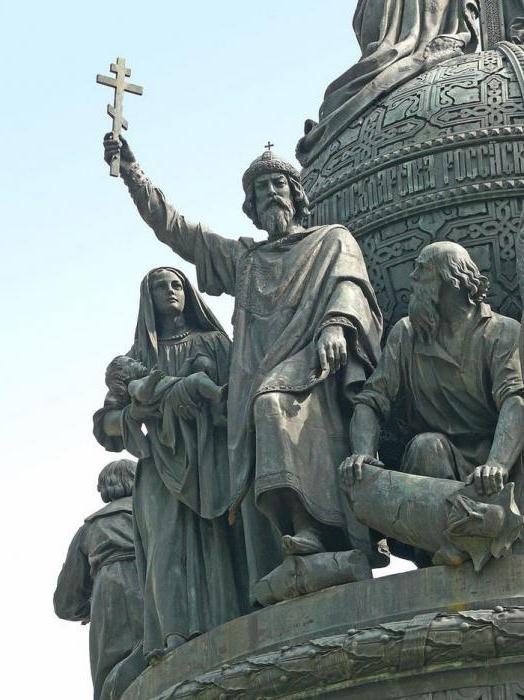Vladimir 1 Svyatoslavovich from 970 to 988 was the prince of Novgorod. In 978, he took control of Kiev and ruled there until the 1015th. Vladimir 1 Svyatoslavovich, whose biography is quite clearly described in the annals, carried out the baptism of Russia. In the face of the saints he was glorified as an equal apostle. In Russian Orthodoxy, on July 15, Vladimir 1 Svyatoslavovich is revered.
Historical portrait
In baptism, the prince was called Basil. Vladimir 1 Svyatoslavovich in epics is known by the name of the Holy, Red Sun. According to legend, his mother was the housekeeper Malusha, a native of Lubech. In accordance with pagan traditions, the son of a slave could be the heir to his father-prince. The exact year in which Vladimir 1 Svyatoslavovich was born is unknown. His father was born, according to the chronicles, in 942. The eldest son of Vladimir - Vysheslav - was born in about 977. Based on this, researchers of the ancient period bring out the year of the birth of the Red Sun - 960.
In accordance with Nestor's Tale, Vladimir was the third oldest son of Svyatoslav after Yaropolk and Oleg. However, there is another hypothesis. According to some reports, he was the second son, because before his father left for Byzantium, he received in 970 a princely table in important Novgorod. And Oleg, in turn, remained in the Drevlyansk land, the center of which was Ovruch. Dobrynya was chosen as a mentor for Vladimir.

In the Scandinavian sagas there is an interesting story about how Olaf I Tryggvason (the future Norwegian king) spent all his childhood and youth in Novgorod land. His mother was forced to flee from the murderers of her husband to King Vladimir (Waldemar). Sigurd, her brother, was serving at that time. However, she and the child were captured by the bandits of Estonia. Sigurd was just in charge of collecting taxes in this country. By chance, he met Olaf and bought him. The boy was brought to Novgorod. Here he grew up under the auspices of Vladimir. Olaf was later accepted into the squad, where he became very popular among warriors.
Vladimir 1 Svyatoslavovich: short biography
After the death of his father in 972, brother Yaropolk became the prince in Kiev. An internecine war broke out between him and the remaining brothers in 977 . Oleg in the battle with Yaropolk during the retreat was crushed by fallen horses in the ditch. Vladimir managed to escape to the Varangian lands. So all Russia began to rule Yaropolk. Meanwhile, Vladimir 1 Svyatoslavovich together with Dobrynya gathered an army in Scandinavia. In 980, he returned to Novgorod and drove the poser Yaropolk. Then he captures Polotsk, who crossed to the side of Kiev. At the same time, Princess Rogneda was forcibly taken by him as a wife.

Yaropolk, meanwhile, hid in Kiev. Vladimir 1 Svyatoslavovich, along with a sufficiently large Varangian army, went to the walls of the city. According to the annals, the governor of Yaropolk was bribed. He persuaded the prince to flee to the small town of Roden. Here Vladimir lured his brother to negotiations, in which two Varangians "raised him with his swords to his bosoms." He took the pregnant wife of Yaropolk as a concubine. After a while, the Varangians demanded a fee for the service. Vladimir first promised them a tribute, but then refused. He sent part of the army to Constantinople, advising the emperor of Byzantium to breed him in different places. Vladimir kept some of the Scandinavians with him.
Pagan rule
Vladimir built a temple in Kiev, where the idols of 6 main gods were installed: Perun, Mokoshi, Stribog, Khors, Dazhdbog, Semargl. There is evidence that the prince carried out human sacrifices, like the Scandinavians. The former Prince Yaropolk established relations with the Latin West and was interested in Christianity. Researchers conclude from this that the fight against the previously established Orthodox faith in Kiev was quite logical. During the period of persecution, the Varangians John and Fedor died - one of the first martyrs in Russia.
Epiphany
In the annals there is a description of the "choice of faiths" by Vladimir. He called to the court the preachers of Judaism, Islam, Catholicism. However, after talking with the "Greek philosopher", he decides to adopt Christianity. According to the annals, in 987 at the boyar council the prince decided to be baptized. As Orthodox sources testify, Vladimir then released all pagan wives from marital duties. Rogneda offered to choose a husband, but she refused, taking monastic tonsure.
In 988, the prince captured Korsun, demanding for his wife Anna, the sister of the emperors of Byzantium, Constantine VIII and Basil II. The rulers, fearing the invasion of the troops of Vladimir, agreed. However, the emperors demanded his baptism for Anna to marry a co-religionist. After receiving consent from Vladimir, they sent a sister with priests to Korsun. The prince and his entire squad underwent a rite, after which a wedding ceremony was performed.
The adoption of Christianity in Russia
After that, Vladimir returned to Kiev and ordered to immediately overturn all idols. An earlier source indicates that the prince was baptized in 988, and he took Korsun three years later and only after that began to demand a wife from the emperors of Byzantium. In Kiev, the conversion of the people to a new faith was relatively peaceful. In Novgorod, baptism was led by Dobrynya. The adoption of a new faith was accompanied here by popular uprisings, which were crushed by force. Rostov-Suzdal land was due to its remoteness relatively autonomous. In this regard, paganism prevailed until the XII century.
Military campaigns
What is famous for Vladimir 1 Svyatoslavovich? The domestic and foreign policy of the prince was aimed primarily at the conquest of neighbors and the annexation of their territories to Ancient Russia. Most of his campaigns were quite successful and allowed to significantly expand the borders of the state. So, in 981 (according to other sources in 979), he fought with Meshko I, the Polish ruler. As a result of the battles, Vladimir captured Przemysl and Cherven. In 981-982 the prince annexed the territory of the Vyatichi. In 983, Vladimir established his rule over Sudovia, subduing the tribe of the Yatvyag. This opened the way for Russia to the Baltic.

In 984, the prince completely conquered the Radimichi. In 985, Vladimir fought along with nomadic torques against the Bulgarians. As a result, a peace favorable to Russia was concluded. In 988, the city of Korsun was captured. According to sources, the city fell after a long siege, when the combatants dug up pipes with water coming from the wells. In 991, as a result of a campaign in the Carpathian lands, they were included in Russia. In 1000, 6 thousand combatants took part in the Byzantine offensive on Armenia. During the reign of Vladimir was able to conclude many profitable agreements with Poland, Byzantium, Hungary, Czech Republic.
Pechenegs
Their raids created constant problems for the prince. In 996, Vasilev had an unsuccessful battle. In 997, the Pechenegs attacked Kiev. In 1001 and 1013 there was a major Polish-Pecheneg invasion. A century later, memories of these events took the form of a folk epos. So, for example, there is a legend about Nikita Kozhemyak, Belgorod kissel, etc. Several fortresses were built along the southern border of Russia to protect against the Pechenegs. On the southeastern and southern limits on the left and right sides of the Dnieper, rows of guard outposts and earthen trenches were withdrawn.
In the years 1006-1007. Bruno of Querfurt (a German missionary) rode through Kiev. He went to the Pechenegs to preach the gospel. Vladimir, taking it at home, tried to dissuade him from the trip. However, the prince failed to convince the missionary. Then Vladimir volunteered to carry him with the squad to the borders. Here Bruno saw a stockade, the length of which was about 800 km.
Children and family
Vladimir 1 Svyatoslavovich in epics is known as the "great libertine." This is also evidenced by the recordings of Timar of Merseburg (German chronicler). In addition, the prince was in several pagan marriages. Among his wives were Rogneda, the “Czech woman” (according to some accounts, Vladimir needed this union to fight the Yaropolk), the “Bulgarian” (it is not known from which Bulgarians there was a wife - Danube or Volga). According to one source, Gleb and Boris were sons of the latter. In addition, in the concubines of Vladimir was a pregnant widow of Yaropolk, who was abducted during one of the campaigns. After a while, she gave birth to Svyatopolk - a son "from two fathers." At the same time, Vladimir considered him his heir. Svyatopolk himself recognized as the father of Yaropolk. He considered Vladimir a usurper.

After the adoption of Christianity, the prince, presumably, was still in two Christian marriages. The first was with Anna, the Byzantine princess. She died in 1011. After her death, there was another wife, an unknown "step-mother of Yaroslav." In total, Vladimir had 13 sons and at least 10 daughters.
Images of a prince
Since 988, silver coins and gold medals have been minted, on which Vladimir 1 Svyatoslavovich was depicted. A photo of the prince is also present on four different Ukrainian banknotes of 1 UAH. (1995-2007 gg.). His image is used on coins of 1 and 10 UAH. In addition, the image was used on a Soviet commemorative coin of 100 rubles. It was released in 1988 in honor of the 1000th anniversary of old Russian coinage. The image of the prince is present on some postal envelopes and stamps.